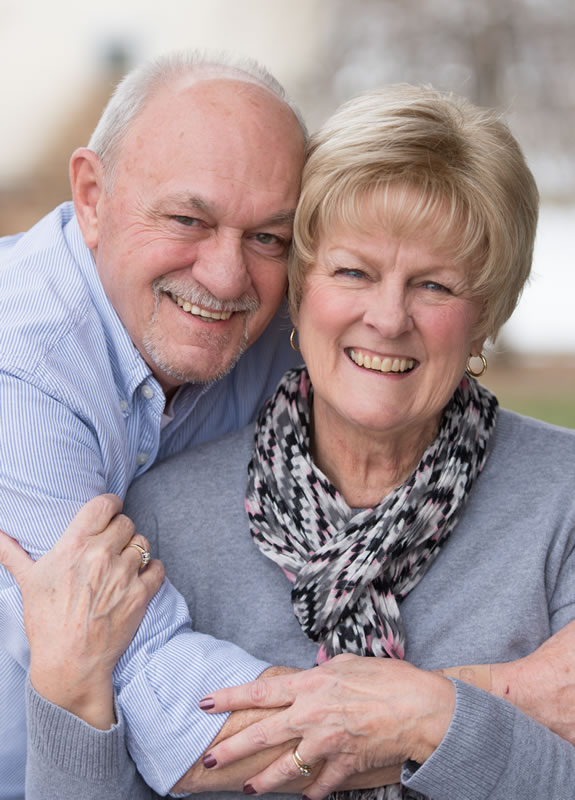Find the Target, Take Aim
One patient tries a clinical trial after gene sequencing reveals proteins feeding her cancer

photo credit: Edda Pacifico
Nancy Van Dyke was so healthy she had never taken an antacid. She rarely saw a doctor. At 64 and recently retired, the long-time employee of Oakridge High School in Muskegon had just started to settle into a retirement lifestyle with plans to travel with her husband Joe and spend time with their adult children and grandchildren.
A gastrointestinal attack in June 2015 led to a surprise trip to her local hospital and within a half hour, doctors suspected the problem was more than gallstones. She was diagnosed with cancer -- they weren't clear of the original location -- that had metastasized to her liver and chest.
Van Dyke visited doctors in Muskegon and traveled to the University of Michigan Rogel Cancer Center to discuss treatment options. Eventually she was diagnosed with bile duct cancer, cholangiocarcinoma. These ducts drain bile from the liver to the small intestine. She tried chemotherapy close to home with no positive results.
Another path to pursue
At the U-M Rogel Cancer Center, Van Dyke opted to have her genes sequenced to identify all types of genetic mutations that could play a role in her cancer. The findings are used to help direct therapies that might work best for patients with advanced cancer.
This area of research, known as precision medicine, is growing rapidly.
Two genes were identified that came together abnormally in her cancer which likely contributes to its growth.
Researchers had seen success stopping the growth of other cancers in instances where a genetic change was present by using new treatments targeted against the effects of that change. But Van Dyke's tumors were in the liver. She was screened to see whether her illness qualified her to participate in a clinical trial: it did not, a huge disappointment.
"Studies have very specific qualifications to ensure the safety of patients participating," says Rashmi Chugh, M.D., VanDyke's oncologist. "These requirements are particularly stringent in phase I studies when we are learning about new agents that haven’t been used in people before. As the studies get further along and we understand the side effects better, there is sometimes increasing flexibility in understanding which patients can safely participate."
Four days later, the situation changed and Van Dyke received approval to join the trial as the first patient with abnormal liver tests due to tumors to try the treatment.

photo credit: Edda Pacifico
Life as a Trial Participant
"My doctors explained to me that the trial might not help me at all, but my participation would help their research. I thought, what do I have to lose," Van Dyke says.
The process began with a visit to the Cancer Center for tests, including an eye exam, EKG, CAT scans and blood work. Documentation is essential in a clinical trial. These are baseline tests for comparison.
Van Dyke's treatment is in pill form. She does not know whether she is being given the trial drug or a placebo. Her care team carefully performs the required tests and measurements as outlined in the study protocol. For example, on day 1 and day 8 of a cycle, she’ll get an EKG within so many minutes of taking her pills.
Is it working?
At the time of our interview, Van Dyke needs to finish the third round before her care team measures changes to her disease. Despite not knowing, she is hopeful.
"I feel healthy," she says. "I am no longer exhausted from chemo or need to take naps during the day. If I can live the rest of my life -- no matter how long it is -- feeling like I do right now, I got my miracle."
If her scans show the drugs are working against her cancer, she will be able to continue taking them.
Also, she feels well cared for by her U-M care team. She describes them as "her girls" and looks forward to seeing them.
"Clinical research is in incredible team effort,” says Chugh. “This includes the faces our patients see in clinic such as nurses, research coordinators, research extenders, physicians, the research infusion team and more. There is also a whole army of faces that patients don't see who are equally important and dedicated to each patient and their clinical research experience. Everyone involved has the same ultimate goal of finding a new strategy to help our patients."
For Van Dyke, she sees the future of health care in her care team.
"They are a group of 20- and 30-something young women with access to the best technology and health information available. When I come up the hill and see the hospital with the big M, I think, Thank you god, for the people in there, the care I've gotten. I feel so blessed."
Update:
9 weeks into treatment, Van Dyke learned her cancer is shrinking. While not every patient on a clinical study experiences benefit from treatment, she and her care team are glad to see a positive impact when standard therapy was ineffective.
Rogel Cancer Center researchers are looking for ways to understand advanced cancers in order to give patients personalized options for treatment. Learn more about MI-ONCOSEQ and whether gene sequencing is an option for you.
Continue reading the Spring, 2016 issue of Thrive.
Learn more about clinical trials:
Read more stories of cancer survivorship:
